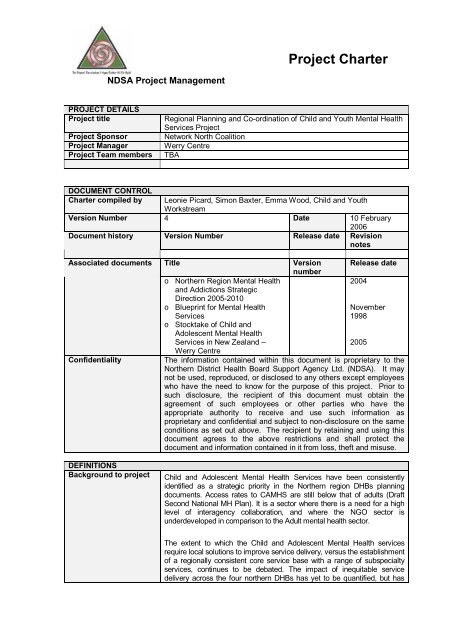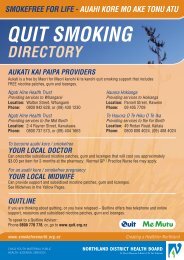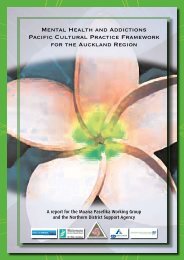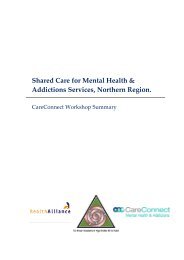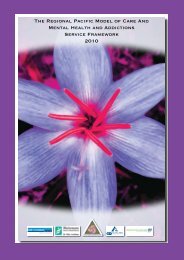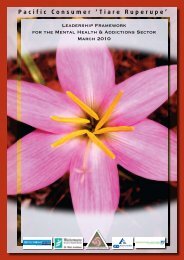Project Charter - Network North
Project Charter - Network North
Project Charter - Network North
Create successful ePaper yourself
Turn your PDF publications into a flip-book with our unique Google optimized e-Paper software.
<strong>Project</strong> <strong>Charter</strong><br />
NDSA <strong>Project</strong> Management<br />
PROJECT DETAILS<br />
<strong>Project</strong> title<br />
<strong>Project</strong> Sponsor<br />
<strong>Project</strong> Manager<br />
<strong>Project</strong> Team members<br />
Regional Planning and Co-ordination of Child and Youth Mental Health<br />
Services <strong>Project</strong><br />
<strong>Network</strong> <strong>North</strong> Coalition<br />
Werry Centre<br />
TBA<br />
DOCUMENT CONTROL<br />
<strong>Charter</strong> compiled by<br />
Leonie Picard, Simon Baxter, Emma Wood, Child and Youth<br />
Workstream<br />
Version Number 4 Date 10 February<br />
Document history<br />
2006<br />
Version Number Release date Revision<br />
notes<br />
Associated documents<br />
Confidentiality<br />
DEFINITIONS<br />
Background to project<br />
Title<br />
o <strong>North</strong>ern Region Mental Health<br />
and Addictions Strategic<br />
Direction 2005-2010<br />
o Blueprint for Mental Health<br />
Services<br />
o Stocktake of Child and<br />
Adolescent Mental Health<br />
Services in New Zealand –<br />
Werry Centre<br />
Version<br />
number<br />
Release date<br />
2004<br />
November<br />
1998<br />
2005<br />
The information contained within this document is proprietary to the<br />
<strong>North</strong>ern District Health Board Support Agency Ltd. (NDSA). It may<br />
not be used, reproduced, or disclosed to any others except employees<br />
who have the need to know for the purpose of this project. Prior to<br />
such disclosure, the recipient of this document must obtain the<br />
agreement of such employees or other parties who have the<br />
appropriate authority to receive and use such information as<br />
proprietary and confidential and subject to non-disclosure on the same<br />
conditions as set out above. The recipient by retaining and using this<br />
document agrees to the above restrictions and shall protect the<br />
document and information contained in it from loss, theft and misuse.<br />
Child and Adolescent Mental Health Services have been consistently<br />
identified as a strategic priority in the <strong>North</strong>ern region DHBs planning<br />
documents. Access rates to CAMHS are still below that of adults (Draft<br />
Second National MH Plan). It is a sector where there is a need for a high<br />
level of interagency collaboration, and where the NGO sector is<br />
underdeveloped in comparison to the Adult mental health sector.<br />
The extent to which the Child and Adolescent Mental Health services<br />
require local solutions to improve service delivery, versus the establishment<br />
of a regionally consistent core service base with a range of subspecialty<br />
services, continues to be debated. The impact of inequitable service<br />
delivery across the four northern DHBs has yet to be quantified, but has
increasingly been seen as an impediment to development for some DHBs.<br />
Strategies for sharing resources within the region in an effective and<br />
efficient manner have yet to be fully explored.<br />
In 2001 CAMHS managers and clinicians began meeting on regular basis<br />
with the purpose of improving co-ordination of services, and to working<br />
cooperatively in service delivery, regional planning and workforce<br />
development issues. This group identified the need to create greater<br />
consistency across the region’s services. This included consistency with<br />
entry criteria and intake processes/documentation, consistency with the<br />
diagnoses, level of severity and exclusions to acceptance of referrals,<br />
prioritisation, screening and triage processes, transfer documentation,<br />
management of waiting lists and communication to referrers. In addition the<br />
group identified a need to address the provision of after-hours service and<br />
regional consumer involvement in services.<br />
More recently the Child and Youth Workstream for the Regional Mental<br />
Health and Addiction Strategic plan 2005-2010 recommended the<br />
establishment of a system for ongoing regional planning and coordination<br />
of child and adolescent services. The group identified the need to develop<br />
guidelines to ensure consistency of CAMH service access across the<br />
region with agreed entry/ exit /transfer criteria and the development of a set<br />
of assessment and evidence-based management standards to ensure<br />
equitable access to care of a high quality. The Child and Youth<br />
Workstream advocated for a number of regional projects to develop the<br />
child and adolescent mental health sector. These projects include:<br />
1. The need to develop rural service delivery models to ensure access to<br />
CAMH services across the region.<br />
2. The development of an agreed standard of assessment, entry, exit and<br />
transfer processes across the CAMHS services in the <strong>North</strong>ern<br />
Region.<br />
3. The development of shared care needs to improve access by children<br />
and adolescents across primary, secondary and tertiary services.<br />
4. The joint planning across a number of services ie primary care, child<br />
health, adult services (17-19 year olds) and addictions services<br />
5. The development of a strategic approach to increasing capacity and<br />
capability of the workforce for child and adolescent mental health<br />
services<br />
6. The need to develop service user representation within existing<br />
regional MH consumer advocacy services<br />
7. Review and expand services for 5-12 year olds.<br />
8. Further development of services for 0-5 year olds<br />
9. Further development of Maori cultural services to children and<br />
adolescents<br />
10. The need to establish Pacific child and adolescent services<br />
11. Further development of consult liaison services in all hospitals<br />
It is important that CAMHS development is responsive to new initiatives<br />
such as the introduction of Individual Packages of Care to complement<br />
existing service; as well as the possibilities that the Primary Care strategy<br />
holds for Child and Youth mental health.<br />
There is continued demand for strong development of Child and Youth<br />
AOD services. Such growth will require engagement from both CAMHS<br />
and the AOD sector<br />
There are opportunities for addressing the issue of workforce<br />
2
<strong>Project</strong> goal<br />
Deliverables (including<br />
measures or indicators of<br />
success)<br />
development through the establishment of the Werry Centre. At a<br />
District Health Board level it has been suggested that the Child and<br />
Youth Mental Health sector has not attracted the new funding that it<br />
might have otherwise because of the perception that any new staffing<br />
positions could not be recruited to. This has been challenged by the<br />
Child and Youth Workstream, who advocated a regional approach to<br />
workforce recruitment and retention.<br />
The project will have several phases to achieve the goal of developing<br />
a service delivery framework for the provision of Child and Youth<br />
Mental Health services in the <strong>North</strong>land region. This will include the<br />
design of a sustainable infrastructure to ensure its implementation.<br />
Phase One<br />
To collect the required information that will be needed to develop a<br />
service delivery framework for the provision of Child and Youth Mental<br />
Health services across the <strong>North</strong>ern Region.(Phase Two and Three).<br />
Phase One will gather this information from:<br />
• NGO services,<br />
• Regional DHB Provider Arm services (ie CADS/AOD, EOS,<br />
ICCS,YFS/CALS)<br />
• Child Health Services (Consult Liaison Starship, General<br />
Paediatrics, Developmental Paediatrics, Youth Health).<br />
Information gained will complement the project that looked at the<br />
commonalities and differences of the CAMHS services<br />
(October 2005)<br />
The purpose of this will be to<br />
• Ascertain the culture of these child and youth services<br />
• Gather information on service delivery models currently used.<br />
• Identify any issues of access to service ie barriers, areas for<br />
improvement<br />
• Identify the effectiveness of interface between DHB and NGO<br />
child and youth mental health services and with other agencies<br />
ie CYF, Youth Justice. This will include the review of any<br />
formal agreements for interface and liaison.<br />
• Process mapping of a service user and their families’ journey<br />
through mental health services. This will assist in looking at<br />
the current model of continuum of care.<br />
• Identify gaps and barriers in service provision<br />
• Look at how access data is collected and utilised<br />
• Provide recommendations to enhance the interface and<br />
alignment of services in the <strong>North</strong>ern region<br />
Phase Two<br />
Development of a service delivery framework for Child and Youth<br />
Services in the <strong>North</strong>ern Region. This will<br />
• Develop a service delivery framework for the <strong>North</strong>ern Region<br />
which utilises information from both the CAMHS commonalities<br />
and differences project, and the outcomes of Phase One of<br />
this project.<br />
• Include how an effective continuum of care will be provided<br />
across the child and youth services.<br />
Benefits of project<br />
Phase Three<br />
The development of an implementation plan which is inclusive of the<br />
design of a sustainable infrastructure. This will provide the direction for<br />
service development and improvement for the Child and Youth<br />
services until 2010. This will be in line with the <strong>North</strong>ern Mental Health<br />
and Addictions Strategic Directions document 2005-2010. This will<br />
then need to be considered by the <strong>North</strong>ern DHBs for implementation.<br />
• Engagement of the Child and Adolescent Mental Health Sector<br />
3
(including measures of<br />
known benefits which<br />
relate to deliverables as<br />
well as less tangible<br />
benefits)<br />
and relevant other groups in the process of establishing the best<br />
mechanism for regional planning and co-ordination.<br />
• Improved access rates for child and adolescent mental health<br />
services.<br />
• The development of a service delivery framework for the<br />
<strong>North</strong>ern region will assist both the access and provision of<br />
services to service users and their family/whanau. This will<br />
result in improved alignment and interface of services so that<br />
there is a more effective continuum of care across services.<br />
• The development of an infrastructure to support and lead<br />
regional child and adolescent mental health sector projects.<br />
Benefits for Maori<br />
(outline benefits which<br />
contribute to Maori Health<br />
gains or Maori<br />
responsiveness)<br />
Coverage (areas,<br />
services, systems, etc.,<br />
affected by project)<br />
Coverage exclusions (if<br />
required for clarification)<br />
Assumptions (if required<br />
for clarification)<br />
ORGANISATIONAL CONTEXT<br />
Alignment to organisations<br />
Vision & Mission, Strategic<br />
Plan and Business Plan<br />
Linkages with other<br />
initiatives (linkages and<br />
interdependencies critical to<br />
project success)<br />
The development of a service delivery framework that recognises the<br />
continuum of care across services, will improve both the alignment and<br />
access to services. This will ensure that there is improved<br />
accessibility to Maori. The development of shared care / collaborative<br />
approaches to service delivery will ensure that partnerships occur with<br />
communities to improve Maori health.<br />
The project will work via the Child and Youth work stream with the four<br />
regional DHBs and the other identified stakeholders.<br />
• Achieving the best outcomes for clients/tangata whai ora and their<br />
families/whanau is a key principle.<br />
• Any developments or initiatives in the CAMH sector in the<br />
<strong>North</strong>ern Region need to be cognisant of the principles of equity of<br />
access and a regionally consistent standard of service, whilst<br />
maintaining local autonomy.<br />
• A proportion of additional Blueprint funding will be specifically<br />
applied to mental health services for the child and youth<br />
population.<br />
The project is aligned with <strong>North</strong>ern Regional Mental Health and<br />
Addictions Strategic Directions Document 2005-2010.<br />
The project will identify and develop linkages with DHB, NGO and<br />
other child and youth services i.e. education, CYF, Justice etc that<br />
are working to improve Child and Youth Mental Health outcomes.<br />
Primary Health linkages will be made through the outcome of the<br />
current project been undertaken by the Primary Mental Health<br />
workstream. This is a stocktake of primary mental health<br />
initiatives that are occurring in both DHBs and PHOs in the<br />
<strong>North</strong>ern Region.<br />
Organisational and other<br />
constraints<br />
Transition to business as<br />
usual (issues that need to be<br />
considered in transferring the<br />
results of this project to the<br />
operational services)<br />
Alcohol and Other Drug Workstream is currently undertaking a<br />
project on reviewing AOD services for Child and Adolescent. The<br />
outcomes of this project will be made available to this project.<br />
Potential organisational constraints are the availability of project<br />
team members to work effectively with the project manager and<br />
commitment of statutory agencies to the project goals.<br />
The involvement of key players in the service delivery sectors in<br />
the project will ensure that the project is relevant to service<br />
delivery at all levels and will be sustainable into the future.<br />
STAKEHOLDERS<br />
4
Key stakeholders<br />
(Maori should be treated as<br />
key stakeholders and a<br />
partnership approach<br />
developed to ensure<br />
appropriate involvement)<br />
• <strong>Network</strong> <strong>North</strong> Coalition<br />
• <strong>North</strong>ern Region DHB CAMHS<br />
• Other NNC work streams<br />
• Paediatric and Youth Health Services<br />
• Maori providers and Iwi<br />
• Moana Pasifika<br />
• Consumer and family groups<br />
Other stakeholders • Education sector<br />
• Welfare Sector<br />
• Youth Justice<br />
• Social Service agencies<br />
• Primary Health Organisations<br />
PROJECT MANAGEMENT APPROACH<br />
<strong>Project</strong> strategy • NDSA will provide <strong>Project</strong> Sponsorship and <strong>Project</strong> Co-ordination<br />
(broad statement of on behalf of the <strong>North</strong>ern Region DHBs.<br />
how project will be<br />
approached)<br />
• The Child and Youth Workstream will identify the appropriate<br />
stakeholders to ensure that the different sectors are included in the<br />
project.<br />
• The Child and Youth Workstream will provide consultation and<br />
guidance where appropriate. This will include reviewing documents<br />
for the different phases of the project, so that the overall project<br />
goal is achieved.<br />
• Child and Youth Workstream Leaders will ensure that project<br />
recommendations are presented to <strong>Network</strong> <strong>North</strong> Coalition and<br />
<strong>North</strong>ern Region DHBs for consideration.<br />
• An emphasis on a collaborative approach with other services will be<br />
maintained throughout the project to ensure that the concept of a<br />
continuum of care for child, youth and their families, is achieved.<br />
<strong>Project</strong> Structure<br />
(describe how<br />
project components<br />
will link together)<br />
• <strong>Project</strong> Manager will be contracted by NDSA ( in consultation with<br />
the Child and Youth Workstream Leaders)<br />
• Regional <strong>Project</strong> Co-ordinator and Child and Youth Workstream<br />
Leaders will establish a <strong>Project</strong> Team.<br />
• <strong>Project</strong> Team and <strong>Project</strong> Manager to meet on agreed regular basis<br />
• Child and Youth Workstream will be used as the reference group<br />
for the project<br />
• Wider consultation groups will be established where appropriate<br />
• Regional <strong>Project</strong> Co-ordinator has delegated responsibility for<br />
<strong>Project</strong> Sponsor, and will consult and seek authorisation for any<br />
project changes when necessary.<br />
• Regional <strong>Project</strong> Co-ordinator and <strong>Project</strong> Manager to ensure<br />
project documentation is maintained as agreed.<br />
• Child and Youth Workstream Leaders to ensure that project<br />
recommendations are reported back to <strong>Network</strong> <strong>North</strong> Coalition and<br />
<strong>North</strong>ern Region DHBs for consideration.<br />
<strong>Project</strong> start date August 2006 <strong>Project</strong> completion date July 2007<br />
Budget<br />
(approximate)<br />
Time required (hrs)<br />
Milestones<br />
• <strong>Project</strong> Manager appointed<br />
• Terms of Reference established<br />
• Phase One <strong>Project</strong> Plan and milestones agreed<br />
• Phase One completed<br />
• Outcomes of Phase One reviewed by Child and Youth Workstream<br />
• Phase Two <strong>Project</strong> Plan and milestones agreed<br />
• Phase Two Completed<br />
• Outcomes of Phase Two reviewed by Child and Youth Workstream<br />
• Phase Three <strong>Project</strong> Plan and milestones agreed<br />
• Phase Three completed<br />
5<br />
Date
• Outcomes of Phase Three reviewed by Child and Youth Workstream<br />
• Regional <strong>Project</strong> Co-ordinator and Child and Youth Workstream<br />
Leaders to present recommendations to NNC and <strong>North</strong>ern Region<br />
DHBs for consideration.<br />
RISKS AND RISK MANAGEMENT<br />
Risk<br />
Probability<br />
(low, med,<br />
high)<br />
Lack of engagement by key<br />
stakeholders<br />
Lack of availability and<br />
commitment of key DHB and<br />
NGO staff<br />
Inability to action<br />
recommendations because of<br />
insufficient funding allocation.<br />
Inability to carry out<br />
Implementation Plan of Phase<br />
Three due to lack of<br />
commitment of key stakeholders<br />
Impact<br />
(low, med,<br />
high)<br />
Risk management strategy<br />
Medium High Ensure key stakeholders – both<br />
mental health and other relevant<br />
health and social services are<br />
engaged in the scoping and<br />
development of the concept and<br />
detailed design from the outset.<br />
Ensure project has a<br />
communication plan to ensure<br />
all stakeholders are informed of<br />
project.<br />
Medium Med Ensure DHB and NGO<br />
commitment to this initiative<br />
through communication strategy<br />
to all stakeholders.<br />
Engagement of Senior<br />
Managers to ensure that<br />
appropriate staff are engaged in<br />
project.<br />
Medium High Ensure key Funding and<br />
Planning persons engaged in<br />
the project.<br />
Medium High Ensure stakeholders are<br />
engaged throughout all three<br />
phases of the project.<br />
STATUS REPORTING<br />
Report readership How often Responsibility<br />
Child and Youth Work Stream<br />
Leaders<br />
Regional <strong>Project</strong> Co-ordinator<br />
<strong>Project</strong> Team<br />
<strong>Project</strong> Sponsor<br />
Monthly<br />
Monthly<br />
Monthly<br />
Monthly<br />
<strong>Project</strong> Manager<br />
<strong>Project</strong> Manager<br />
<strong>Project</strong> Manager<br />
<strong>Project</strong> Co-ordinator<br />
AUTHORISATION<br />
<strong>Project</strong> Sponsor<br />
Derek Wright on behalf of the<br />
<strong>Network</strong> <strong>North</strong> Coalition<br />
Date February 2006<br />
6


